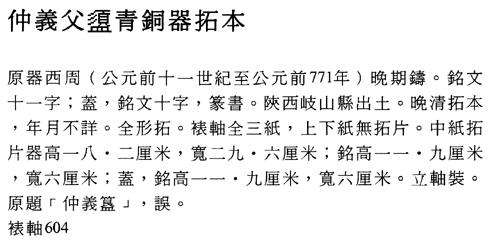 |
|
|
 |
|
|
Rubbings from the
Inscribed Bronze Tureen "Zhong Yi Fu" Xu Late
Western Zhou dynasty (ca. 1100�771 b.c.e.),
undated Hanging
scroll, ink rubbed on paper; 148.8 x 42.6 cm (comprising sheet mounted above:
27.7 x 42.6 cm; sheet mounted at center with rubbings: 97.4 x 42.6 cm; and
sheet mounted below: 23.7 x 42.6 cm); rubbing of vessel: approx. 18.2 x 29.6
cm; rubbing of inscription at upper right: approx. 11.9 x 6.0 cm; rubbing of
inscription at upper left: approx. 11.9 x 6.0 cm Date
of rubbing not given; Qing dynasty (1644�1911), late 19th�early 20th century Inventory number: Biaozhou 604 The
xu,
an oblong container for rice and sorghum that was also used as a grain-offering
vessel in rituals, has a slightly flared mouth and a lid with appendages in the
form of rectangles or small animals, which enable it to function as a separate
container when reversed.� The vessel has
handles and a foot ring, and a small number of this type feature animal-feet
supports.� The xu closely resembles another
bronze vessel type, the gui, in square or rectangular form, and
certain inscriptions on xu even refer to them as gui.� The xu, popular in the mid- and late Western
Zhou periods, was an immediate variation of the gui. The
xu
shown in this fine full-figured rubbing bears an 11-character inscription on
the container and a 10-character inscription on the lid, including reference to
a certain "Zhong Yi Fu," from which the vessel takes its name.� Once owned by the collector Wu Dacheng
(1835�1902), its present whereabouts is unknown.� The rubbing carries a colophon in seal script by Han Huixun, in
which his identification of the vessel as a gui is mistaken. |
 |